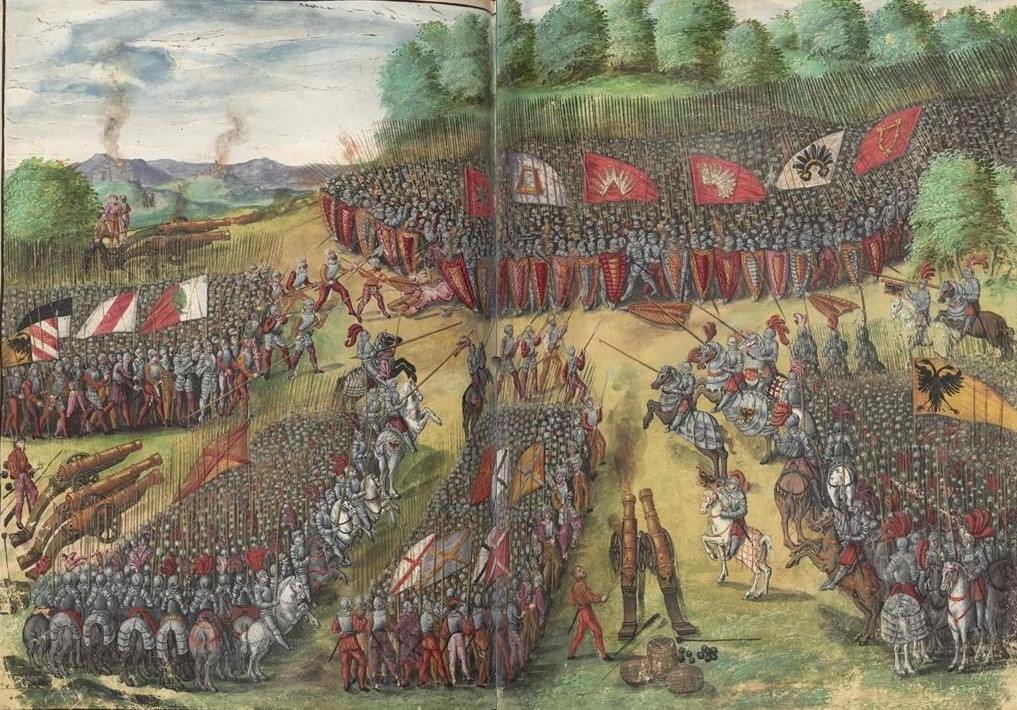
Battle of Wenzenbach
Behamisch facht (Böhmisches Gefecht) aus dem Weißkunig, Holzschnitt 175.
The Bohemians are positioned on top of a hill at the center; tree-covered hills
recede into the background at the right. The Bohemian troops’ shields form a
protective barrier while they point their spears outward against the cavalry
approaching from the right and the foot soldiers from the left. A mass of
spears pointing inward from both sides of the composition leads the eye to the
doomed soldiers in the middle. On the left behind the advancing forces, Schönberg
Castle burns, blasting billows of smoke upward into the sky.
Triumphzug Kaiser Maximilians I. (die Böhmenschlacht und der böhmische
Trophäenwagen) von Albrecht Altdorfer (Regensburg um 1512–1515). In this work,
begun around 1512, a section of the frieze attributed to Altdorfer himself
shows two battles from the War of Succession displayed on banners, one
helpfully inscribed `Der Bayrisch krieg’ (showing the Siege of Kufstein) and
the other, `Die Behemisch slacht’ (Fig. 13.2). Altdorfer’s miniature faithfully
follows Treitzsaurwein’s instructions, as behind the scene of the `Bayrisch
krieg’, three men parade on horseback holding banners with the coats-of-arms of
the three territories Maximilian claimed for himself at the Kölner Spruch.
Battle of Wenzenbach in Codex Germanicus. Note Emperor Maximillian I’s
fall left foreground.
The `Bohemian battle’, also variously referred to as the `Battle
of Wenzenbach’ and the `Battle of Schönberg’, took place on September 12, 1504
and was an important battle in the Landshut War of Succession, a conflict that
marked the culmination of over a hundred years of territorial squabbling among
the four Wittelsbach lines of Bavarian dukes. By the middle of the fifteenth
century, the deaths of two dukes without male issue had consolidated the four
duchies into two: Bavaria-Landshut and Bavaria-Munich. Lacking an heir, Duke
Georg `the Rich’ of Bavaria-Landshut named the Palatine branch of the
Wittelsbachs as his beneficiaries in his 1496 will, hoping to keep his
territories out of the hands of the Munich line. However, these dynastic
machinations were not legally valid, as they expressly went against the stipulations
worked out by previous Wittelsbach rulers in their divisional agreement of 1392
(and its subsequent renewal in 1450) that when one line died out the
territories would go to the other Bavarian Wittelsbach lines. Georg’s own
advisors counseled him that the will could not be upheld. The Holy Roman
Emperor Maximilian I agreed and sustained the provision that should Georg die
without male issue, the surviving Wittelsbach duke of Bavarian
territories-Albrecht IV of Bavaria-Munich- would succeed him. In December 1503,
Georg died without having rescinded his will of 1496, and the Landshut War of
Succession broke out the next year between the Palatine supporters and the
Munich faction with Habsburg and imperial backing. The Battle of Wenzenbach
proved to be the largest and bloodiest meeting of troops during the war.
Ludwig’s father, Albrecht IV, and his maternal uncle, Maximilian I, achieved a
resounding victory over the Palatine forces, which included a huge number of
Bohemian mercenaries (hence the battle’s nickname). The battle was not all
smooth sailing, however. Maximilian’s horse stumbled and the emperor fell; he was
almost trampled to death before being pulled free and helped back into the
saddle by Duke Ernst of Braunschweig-Lüneberg. As a result of the Battle of
Wenzenbach, the war subsequently fizzled to its eventual conclusion. At the
Reichstag in July 1505, the Emperor brought an end to the conflict with the
Kölner Spruch (verdict at Cologne), in which he gave rulership of the duchy of
Bavaria-Landshut to his brother-in-law, Albrecht, and claimed for himself the
three most profitable Bavaria-Landshut territories located in the Alps, in
effect a commission for resolving the conflict. The Battle of Wenzenbach proved
to have been a critical factor in the war’s eventual outcome.
Georg von Frundsberg
Georg von Frundsberg fought for the Habsburg emperor
Maximilian I against the Swiss Confederacy in the Swabian War of 1499, where he
had to realize that the era of the heavy armoured knights was well and truly
over. In the same year he was among the Imperial troops sent to the aid of
Ludovico Sforza, who had been deposed as Duke of Milan by King Louis XII of
France. When Maximilian appointed him Tyrolean military captain, he recruited a
powerful army of pike square infantry formations following the Swiss example.
Still serving Maximilian, he took part in the 1504 War of
the Succession of Landshut, fighting against Count Ruprecht of the Palatinate
and his father Elector Palatine Philip. Frundsberg distinguished himself
leading a Landsknecht regiment into the decisive Battle of Wenzenbach,
whereafter Maximilian I personally bestowed knighthood on him: armed with
muskets and culverines, the Frundsberg regiment broke a breach into the
wagon-wall of the Bohemian mercenaries (composed 300+ wagons), which were then
routed. Convinced of the necessity of a native body of trained infantry,
Frundsberg assisted Maximilian in the organization of the Landsknecht troops.
One year later, he became the commander of the Landsknechts in the Habsburg
Netherlands.
A detailed description of this battle can be found in Friedrich Dörnhöffer, `Ein Cyclus von Federzeichnungen mit Darstellungen von Kriegen und Jagden Maximilians I’, Jahrbuch der Kunsthistorischen Sammlungen des Allerhöchsten Kaiserhauses, 18 (1897): 45-46.